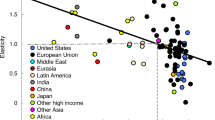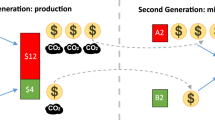Abstract
Mitigation of anthropogenic climate change takes place against the backdrop of poor countries being most affected by climate change impacts; climate-induced migration is expected to increase in the future. However, the interaction between mitigation, climate migration and poverty has not been investigated explicitly. Here, we represent simultaneous poverty- and climate-induced migration in a laboratory setting, within the collective-risk social dilemma that arises from attempts to avert dangerous climate change. The relatively rich participants try to prevent migration by the relatively poor but in the long run these attempts are unsuccessful because of free-riding among the rich. The rich are willing to increase their effort at averting dangerous climate change when the poor are hit by a climate extreme event exacerbating their poverty. Conversely, the poor are willing to compensate some weaker effort by the rich, as long as the effort by the rich lies above a threshold emerging within the experiment.
This is a preview of subscription content, access via your institution
Access options
Access Nature and 54 other Nature Portfolio journals
Get Nature+, our best-value online-access subscription
$29.99 / 30 days
cancel any time
Subscribe to this journal
Receive 12 print issues and online access
$209.00 per year
only $17.42 per issue
Buy this article
- Purchase on Springer Link
- Instant access to full article PDF
Prices may be subject to local taxes which are calculated during checkout






Similar content being viewed by others
Data availability
The dataset generated and analysed during the current study is available at https://pure.mpg.de/pubman/faces/ViewItemFullPage.jsp?itemId=item_3217143 and http://hdl.handle.net/21.11116/0000-0006-5492-6. Source Data for Figs. 1–6 and Extended Data Figs. 1–4 are provided with the paper.
Code availability
The data analysis code is available from the corresponding author on request.
References
Adger, W. N. et al. in Climate Change 2014: Impacts, Adaptation, and Vulnerability (eds Field, C. B. et al.) 755–791 (Cambridge Univ. Press, 2014).
Winsemius, H. C. et al. Disaster risk, climate change, and poverty: assessing the global exposure of poor people to floods and droughts. Environ. Dev. Econ. 23, 328–348 (2018).
Hallegatte, S., Fay, M. & Barbier, E. B. Poverty and climate change: an introduction. Environ. Dev. Econ. 23, 217–233 (2018).
Hansen, J. et al. Climate risk management and rural poverty reduction. Agric. Syst. 172, 28–46 (2019).
Zander, K. K., Surjan, A. & Garnett, S. T. Exploring the effect of heat on stated intentions to move. Clim. Change 138, 297–308 (2016).
Shayegh, S. Outward migration may alter population dynamics and income inequality. Nat. Clim. Change 7, 828–832 (2017).
McLeman, R. International migration and climate adaptation in an era of hardening borders. Nat. Clim. Change 9, 911–918 (2019).
Black, R. et al. The effect of environmental change on human migration. Glob. Environ. Change 215, S3–S11 (2011).
Cattaneo, C. & Peri, G. The migration response to increasing temperatures. J. Dev. Econ. 122, 127–146 (2016).
Ravenstein, E. G. The laws of migration. J. R. Stat. Soc. 48, 167–235 (1885).
Bourne, S. Discussion of Mr. Ravenstein’s paper. J. R. Stat. Soc. 52, 303 (1889).
Lee, E. S. A theory of migration. Demography 3, 47–57 (1966).
Stark, O. & Bloom, E. D. The new economics of labor migration. Am. Econ. Rev. 75, 173–178 (1985).
Porumbescu, A. Defining the new economics of labor migration theory boundaries: a sociological-level analysis of international migration. RSP 45, 55–64 (2015).
Stark, O. The Migration of Labour (Basic Blackwell, 1991).
McLeman, R. Settlement abandonment in the context of global environmental change. Glob. Environ. Change 21, S108–S120 (2011).
Chen, J. & Mueller, V. Coastal climate change, soil salinity and human migration in Bangladesh. Nat. Clim. Change 8, 981–985 (2018).
Mastrorillo, M. et al. The influence of climate variability on internal migration flows in South Africa. Glob. Environ. Change 39, 155–169 (2016).
Böhm, R., Theelen, M. M. P., Rusch, H. & Van Lange, P. A. M. Costs, needs, and integration efforts shape helping behaviour toward refugees. Proc. Natl Acad. Sci. USA 115, 7284–7289 (2018).
Abel, G. J., Brottrager, M., Guaresma, J. C. & Muttarak, R. Climate, conflict and forced migration. Glob. Environ. Change 54, 239–249 (2019).
Smith, V. L. Papers in Experimental Economics (Cambridge Univ. Press, 2010).
Milinski, M., Sommerfeld, R. D., Krambeck, H.-J., Reed, F. A. & Marotzke, J. The collective-risk social dilemma and the prevention of simulated dangerous climate change. Proc. Natl Acad. Sci. USA 105, 2291–2294 (2008).
Milinski, M., Röhl, T. & Marotzke, J. Cooperative interaction of rich and poor can be catalyzed by intermediate climate targets. Clim. Change 109, 807–814 (2011).
Tavoni, A., Dannenberg, A., Kallis, G. & Löschel, A. Inequality, communication, and the avoidance of disastrous climate change in a public goods game. Proc. Natl Acad. Sci. USA 108, 11825–11829 (2011).
Chen, X., Szolnoki, A. & Perc, M. Risk-driven migration and the collective-risk social dilemma. Phys. Rev. E 86, 036101-1-8 (2012).
Jacquet, J. et al. Intra- and intergenerational discounting in the climate game. Nat. Clim. Change 3, 1025–1028 (2013).
Burton-Chellow, M. N., May, R. M. & West, S. A. Combined inequality in wealth and risk leads to disaster in the climate change game. Clim. Change 120, 815–830 (2013).
Abu Chakra, M. & Traulsen, A. Under high stakes and uncertainty the rich should lend the poor a helping hand. J. Theor. Biol. 341, 123–130 (2014).
Milinski, M., Hilbe, C., Semmann, D., Sommerfeld, R. & Marotzke, J. Humans choose representatives who enforce cooperation in social dilemmas through extortion. Nat. Commun. 7, 10915 (2016).
Hagel, K., Milinski & Marotzke, J. The level of climate-change mitigation depends on how humans assess the risk arising from missing the 2°C target. Palgrave Commun. 3, 17027 (2018).
Vincens, J. et al. Resource heterogeneity leads to unjust effort distribution in climate change mitigation. PLoS ONE 13, e0204369 (2018).
Waichman, I., Requate, T., Karde, M. & Milinski, M. Challenging Conventional Wisdom: Experimental Evidence on Heterogeneity and Coordination in Avoiding a Collective Catastrophic Event KCG Working Paper no.19 (Kiel Institute for the World Economy, 2019).
Schneider, S. H. What is ‘dangerous climate change’? Nature 411, 17–19 (2001).
Meinshausen, M. et al. Greenhouse-gas emission targets for limiting global warming to 2 °C. Nature 458, 1158–1162 (2009).
Peters, G. P. et al. The challenge to keep global warming below 2 °C. Nat. Clim. Change 3, 4–6 (2013).
IPCC Climate Change 2014: Synthesis Report (eds Core Writing Team, Pachauri, R. K. & Meyer L. A.) (IPCC, 2014).
Hardin, G. The tragedy of the commons. Science 162, 1243–1248 (1968).
Gao, B., Liu, X., Hou, S., Jia, D. & Du, M. Resolving public goods dilemma by giving the poor more support. Appl. Math. Comput. 362, 124529 (2019).
Gächter, S., Mengel, F., Tsakas, E. & Vostroknutov, A. Growth and inequality in public good provision. J. Public Econ. 150, 1–13 (2017).
Fischbacher, U. z-Tree: Zurich toolbox for ready-made economic experiments. Exp. Econ. 10, 171–178 (2007).
Sokal, R. R. & Rohlf, F. J. Biometry 2nd edn (W. H. Freeman, 1981).
Acknowledgements
We thank the students from the universities of Hamburg and Kiel for their participation. We also thank H. Brendelberger and S. Dobler for logistic support. M.M. acknowledges discussion at the NIMBioS sustainability conference at Knoxville. This study was supported by the Max Planck Society for the Advancement of Science.
Author information
Authors and Affiliations
Contributions
M.M. conceived the study. M.M. and J.M. designed the study. D.S. wrote the z-Tree program. D.S. and M.M. performed the research. M.M. analysed the data. M.M. and J.M. wrote the paper and all authors revised the manuscript.
Corresponding authors
Ethics declarations
Competing interests
The authors declare no competing interests.
Additional information
Peer review information Nature Climate Change thanks Reuben Kline, Mathew Hauer and the other, anonymous, reviewer(s) for their contribution to the peer review of this work.
Publisher’s note Springer Nature remains neutral with regard to jurisdictional claims in published maps and institutional affiliations.
Extended data
Extended Data Fig. 1 Harvest per inhabitant per round (€).
in the rich country and the poor country dependent on the number of inhabitants. (a) with low overall harvest in T0 and T1, (b) with high overall harvest in T2.
Extended Data Fig. 2 Number of complete blockades.
Mean + s.e.m. per group in T0, T1 and T2. P after Mann–Whitney U-test, n1 = 14, n2 = 14, z = −2.955. Effective blockings (mean ± s.e.m.) per group: 2.5 ± 0.7 in T0, 1.8 ± 0.2 in T1, and 7.1 ± 1.7 in T2, respectively.
Extended Data Fig. 3 Risk of climate event.
Group size per group (mean ±s.e.m.) in the last 5 rounds per round in the poor country in T0, in T1 and T2 dependent on the risk of a climate event to occur of either 0%, n = 13, 10%, n = 7, or 20%, n = 7, per round. There are fewer inhabitants in the poor country during the last five rounds with increasing risk of climate events (n = 3 treatments, P = 0.005, h = 10.534, Kruskal–Wallis test).
Extended Data Fig. 4 Absolute Spearman rank correlation coefficients.
rho, mean + s.e.m., between contributions of one class of players to contributions of the other class of players in previous round over 19 rounds per group. Poor player reacts to rich player’s contribution in previous round, rich player reacts to poor player’s contribution in previous round; a. T0, n = 13 groups of 10 players each, b. T1, n = 14 groups of 10 players each, c. T2, n = 14 groups of 10 players each; d. T0, 7 groups of 10 players each, where rich players contributed at least €300 total per group, e. T1, 8 groups of 10 players each, where rich players contributed at least €300 total per group. P calculated from Fisher combination test41, a. combining P values from each of 13 (T0), b, c. of 14 (T1, T2), d. of 7 (T0), e. of 8 (T1) independent groups of 10 players each. For each group the Spearman correlation coefficient rho was calculated from 19 rounds, providing a single p-value.
Supplementary information
Supplementary Information
Supplementary Notes 1–4.
Source data
Source Data Fig. 1
Source Data.
Source Data Fig. 2
Source Data.
Source Data Fig. 3
Source Data.
Source Data Fig. 4
Source Data.
Source Data Fig. 5
Source Data.
Source Data Fig. 6
Source Data.
Source Data Extended Data Fig. 1
Source Data.
Source Data Extended Data. Fig. 2
Source Data.
Source Data Extended Data Fig. 3
Source Data.
Source Data Extended Data Fig. 4
Source Data.
Rights and permissions
About this article
Cite this article
Marotzke, J., Semmann, D. & Milinski, M. The economic interaction between climate change mitigation, climate migration and poverty. Nat. Clim. Chang. 10, 518–525 (2020). https://doi.org/10.1038/s41558-020-0783-3
Received:
Accepted:
Published:
Issue Date:
DOI: https://doi.org/10.1038/s41558-020-0783-3
This article is cited by
-
Information about historical emissions drives the division of climate change mitigation costs
Nature Communications (2023)
-
Exploring interactions between socioeconomic context and natural hazards on human population displacement
Nature Communications (2023)
-
Adaptation, flourishing, and the importance of place
Regional Environmental Change (2023)
-
Safe and just Earth system boundaries
Nature (2023)
-
Climate risks and adaptation strategies of farmers in East Africa and South Asia
Scientific Reports (2021)



